Contents

This is a very interesting question that worries many anglers. Although, on the other hand, this is not entirely important if there are no restrictions on catching fish. Some of them determine the approximate age by the size of the fish. But the size and weight of the fish may depend on a number of factors, including the availability of food in the reservoir. Therefore, this approach gives only approximate results, although quite satisfactory.
There is another way by which you can find out a more accurate age of a fish, similar to how the age of a tree on a cut is calculated using annual rings. You can find out about this by the scales, if you carefully examine it, by the bones and gills. Experts involved in this field know almost everything about fish: how old they are, how intensively they grew, how many times they spawned, etc. In other words, fish scales are like a calling card, or more precisely, like a passport.
Determining the age of fish by scales
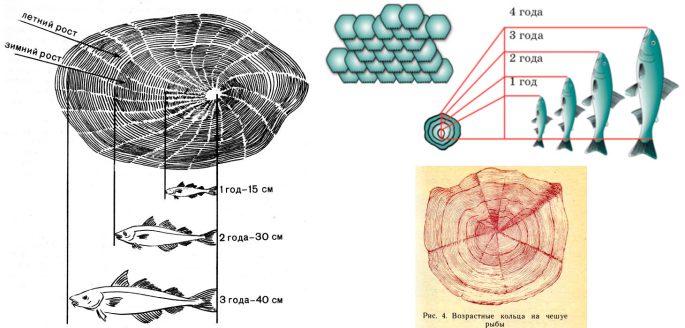
If you look at the scales with a microscope, you can see peculiar rings on it, very similar to those that are observed on a cut of a tree. Each ring is a witness to another lived year. By the scales, it is realistic to determine both the age of the fish and its length, by which it has grown over the previous year.
Instances up to 1 meter long have scales with a radius of up to 1 centimeter. The distance from the annual ring (initial) to the central part of the scale is about 6 mm. Based on this information, it can be determined that the fish has grown by 60 cm in a year.
If you look at the scales under a microscope, you can see another, but very important feature – this is the uneven surface. On the scales you can see ridges and depressions, which are also called sclerites. During one year of life, 2 layers of sclerites appear – large and small. A large sclerite indicates a period of active growth of the fish, and a small one indicates the experienced autumn-winter period.
If you accurately determine the number of double sclerites, then you can simply determine the age of the fish. But, even in this case, you need to have certain skills.
But this is not a problem if the fish has large scales. At the same time, there are fish species that have rather small scales and this method is not suitable, since it is not possible to calculate how long the fish has lived. That is, it is possible to calculate it, but this will require special equipment. In this case, the skeleton is taken as the basis for calculating the age of the fish. Based on this, we can conclude that it is not at all easy for an ordinary person to cope with this task, since the process requires special tools.
How do annual rings form in fish?
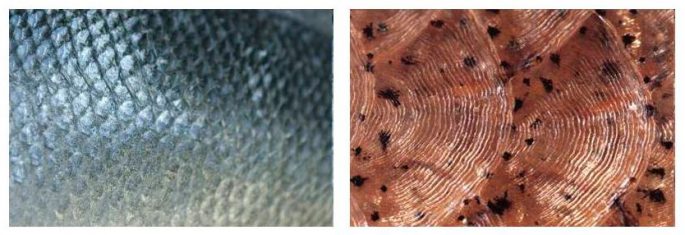
To correctly and accurately determine the age of the fish, it is necessary to know the physiology of the growth of annual rings.
If you look closely, you can see that the rings are distributed in several stages: behind the wide and light rings are narrow and dark rings. A wide ring indicates the moments when the fish actively grew and developed. As a rule, it is spring, summer and autumn. The dark ring is formed when the fish is in cold water with little to no food. Sometimes it is difficult to identify dark rings in fish, which indicates difficult wintering conditions.
Such rings are formed because the bones of the fish and its scales are endowed with such a feature as the appearance of layers, depending on the living conditions. On the other hand, uniform scale or skeletal development is only possible if the fish are in ideal conditions, which never happens.
Each lived year of a fish’s life does not go unmarked on scales or fish bones. At first, the scale consists of a transparent plate. A year later, a second plate forms under it, which goes beyond the edge of the first. Then a third, then a fourth, and so on. If the fish is about 5 years old, then its scales consist of 5 plates, one after the other. Such a construction resembles a layer cake, when the smallest, but the oldest plate is on top, and the largest, but the youngest, is on the bottom.
How can you see the annual rings in fish
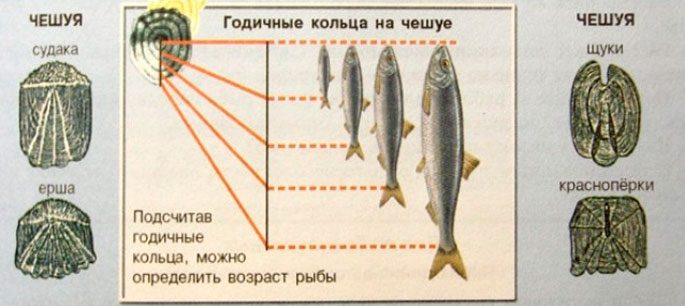
It is very problematic to count or detect annual rings in fish, especially with the naked eye. Therefore, you need to have a magnifying glass or binoculars if everything happens on a pond. If you decide to deal with this problem at home, then it is better to arm yourself with a microscope. Before the process itself, you need:
- Prepare the scales for inspection and, if necessary, rinse it with alcohol.
- For inspection, it is better to take the largest scales, which are located on the sides.
- The scale should not have mechanical damage.
For more accurate calculations, it is necessary to take into account the absolute and relative size of sclerites. Under a microscope, annual rings, ridges and cavities will be visible. After several such approaches, it is possible to determine the age of the fish realistically and with great accuracy.
How is the age of a fish calculated?
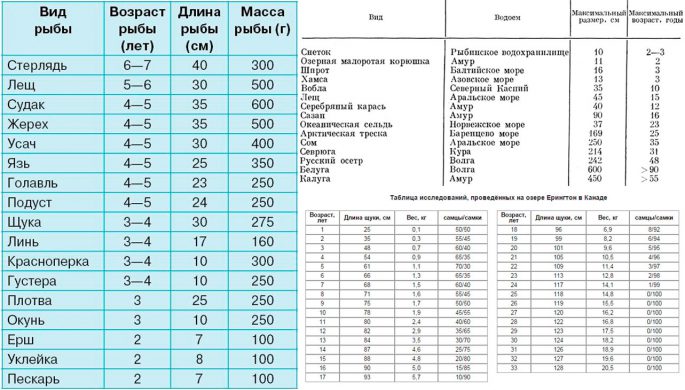
Using scales and bones, it is possible to determine with a certain accuracy the age of the fish or its growth a year earlier. This will require a microscope and some tools. According to the state of the scales, it is realistic to determine what happened to the fish during spawning periods, for example. In some species of fish, when it goes to spawn, the scales break off. By this factor, you can determine how many times the fish has already spawned in its life.
How to determine the age of a fish?
Determination of the age of fish of various species
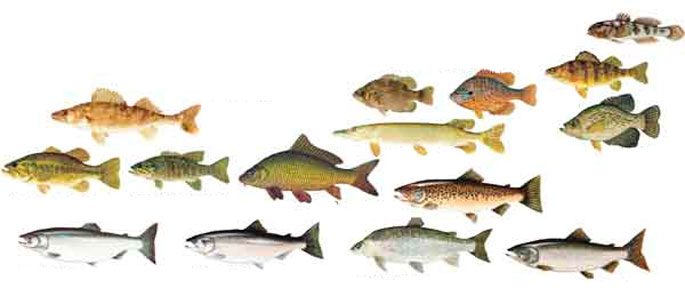
The age of a fish is always easier to determine if it has thin but long scales. So, it is much easier to determine the age of pike, taimen, grayling, herring and many other fish species.
It is much more difficult to determine the age of perch, burbot or eel. In this case, you will have to take flat bones as a sample. The age of sturgeons is determined by the large rays of the dorsal fins. To do this, take the largest beam and cut it off at its widest point. Then the cut is polished to transparency, after which it will be possible to see the annual rings. After that, the age is calculated according to the generally accepted method, which is applied to the scales. This approach is used to determine the age of other fish species, such as catfish.
In addition to these methods, there is another method, which is based on the study of gills. On the gill covers, marks, similar to those on the scales, remain after each lived year. Scientists have determined that even fish that do not have a skeleton have their own annual rings. Such rings are formed on the thick rays of the pectoral fins.
To determine the abundance of a particular species of fish, it is necessary to understand how dynamically a particular species of fish is developing. There are species that spawn quite late. If we take the Amur salmon, then it only begins to spawn at the age of 20. And so, if you go through the individual species, you can understand that each species develops absolutely independently of one another and each species lives for a certain period of time. It is very important for science to know how long a particular fish species can live in order to control the populations of certain fish species. As for anglers, for them the approximate age of the fish does not mean anything significant.









